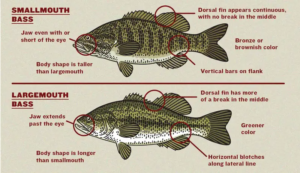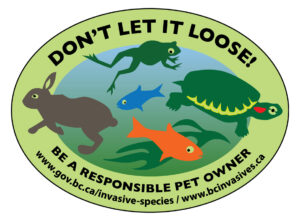SMALLMOUTH BASS (Micropterus dolomieu)
FOUND IN B.C.? Yes.
CURRENTLY KNOWN IN: Southern Vancouver Island, Okanagan, Thompson, Kootenay and Cariboo regions.
Identification

Smallmouth bass. Photo credit: Eric Engbretson, US Fish and Wildlife Service, Bugwood.org
Smallmouth Bass are invasive fish that have an oval shaped flat body that can grow to be 25-40 centimetres long. They have two dorsal fins that are fused together, a pointed face, and their mouth extends just below the eye. The back side of this fish is grey-green to brown in colour, the sides are lighter, and the bottom side is white.

Main physical differences between Smallmouth and Largemouth bass. Photo credit: Field and Stream
Understandably, Smallmouth Bass are often confused with Largemouth Bass, another fish that is invasive in BC. The two main differentiating features of these two fish are the pattern along the side body and the size of the mouth. Smallmouth Bass have multiple dark vertical stripes along their side body, while largemouth bass have a single dark horizontal stripe. Largemouth Bass have a larger mouth that extends past the eye, while the smaller mouth of Smallmouth Bass ends in line or before their eye.
Life Cycle
Smallmouth bass populations can rapidly increase once established in a new environment. As long as water temperatures remain above 15 ℃, females can spawn multiple times in a year, producing 10,000 eggs each time. Spawning sites usually have some cover available in shallow water with sandy or gravel bottoms. Males are responsible for guarding the eggs, and will prepare a nest site for the female to spawn. Usually it takes about 6 years for Smallmouth Bass to reach their full length, and their lifespan is about 15-18 years.

Photo Credit: https://www.dfo-mpo.gc.ca/species-especes/profiles-profils/smallmouthbass-achiganpetitebouche-eng.html
Ecology
The preferred habitat of Smallmouth Bass is clear freshwater systems, such as streams, rivers, and ponds with a gravel or sandy bottom. They prefer areas with a small amount of aquatic vegetation, and logs or docks that provide shelter. During the cold winter months, Smallmouth Bass retreat to deeper waters and are dormant. Once the waters warm up, they return to shallow water to feed and spawn. Their diet is quite varied, and they consume a wide range of prey species, including aquatic invertebrates, juvenile fish, small amphibians, and sometimes even birds. These fish are adaptable to a wide range of habitat types and food resources, allowing them to further expand into new areas.
Introduction and Spread
Smallmouth bass are native to Eastern North America, to the Great Lakes and St Lawrence system. These fish are popular sport fish, and are spreading to BC through intentional introductions for recreational fishing, and accidental introductions as escaped live bait. Until the late 1900s, introductions of Smallmouth bass from their native range into other parts of Canada was permitted, as it is a popular sport fish.

Smallmouth Bass. Photo credit: Missouri Department of Conservation
Impacts
Smallmouth bass are aggressive predators that feed on a wide variety of prey species and have a negative impact on the native species and their environments. They deplete waterways of smaller fish species, including juvenile salmon. This presents a risk to BC’s commercial and recreational fisheries. These fish carry diseases that can spread to and harm native species, and have caused a decline in native species in other areas where they have been introduced. Their prolific spawning, adaptability to a variety of habitats and food sources, and aggressive predation make them successful invaders that deplete resources for native species.
What Can We Do?


To help prevent the spread of these fish further, there are several things you can do.
- Do not possess, transport, or release Smallmouth bass anywhere in BC
- Never use live fish as bait
- Don’t Let it Loose – do not release your aquarium pets into the wild, as they can become invasive and harm the natural environment
- Raise awareness of invasive species in BC!
- Clean, Drain, and Dry all watercraft before and after use to prevent spreading aquatic invasive species
- Do not transport any organisms from one water body to another
- Report all sightings of invasive species to CSISS on our website, to the Province with their online form or on the Report Invasive mobile app.
Literature and Resources:
- https://www2.gov.bc.ca/assets/gov/environment/plants-animals-and-ecosystems/invasive-species/alerts/smallmouth_bass_alert.pdf
- https://bcinvasives.ca/invasives/smallmouth-bass/
- https://www.tackleshare.com/resources/smallmouth-bass/#:~:text=Spawning%20Patterns,on%20sand%20to%20gravel%20bottoms.
- https://www.dfo-mpo.gc.ca/species-especes/profiles-profils/smallmouthbass-achiganpetitebouche-eng.html
- https://mdc.mo.gov/discover-nature/field-guide/smallmouth-bass
Please get in touch by toll-free phone (1-855-785-9333) or email (info@columbiashuswapinvasives.org) for information!